Many merchants believe that it’s hard to provide round-the-clock customer support because it requires people to be awake and logged on 24/7.
Thanks to modern software, this is no longer the case. Conversational commerce has changed the game.
Key points about conversational commerce:
- Conversational commerce revolutionizes customer service by using chatbots and messaging platforms to engage customers in real-time.
- 80% of consumers are more likely to buy from brands that offer a personalized experience, and 90% express a strong inclination towards personalization.
- With Omnisend, you can integrate your business with conversational commerce apps and effortlessly manage the entire customer journey.
Table of Contents
What is conversational commerce?
Main channels of conversational commerce
Conversational commerce examples and use case
Benefits of conversational commerce for your businesses
How to optimize your business for conversational commerce
How to get started with conversational commerce
Wrap up
What is conversational commerce?
Conversational commerce is a digital approach to customer service. It uses chatbots and messaging platforms to engage with customers in real-time and provide an interactive shopping experience.
In this process, customers can engage with brands directly through various messaging platforms to:
- collect product details
- receive customer support
- chat with a company representative
- get personalized recommendations
- get personalized advice
- read reviews
- make a purchase
The idea is to create a seamless user experience for the customer by assisting them in their favorite communication platform.
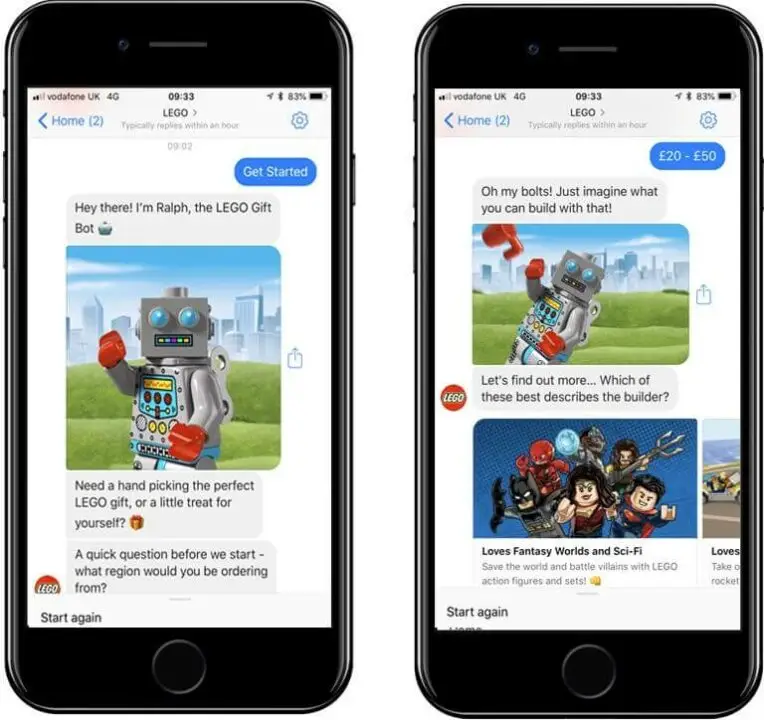
In doing so, the customer may interact with one of the company’s human representatives, a chatbot, or a mix of both.
The good thing is that when making a purchase, customers don’t even have to leave the messaging app they are using.
Because of the ease and convenience, this style of commerce is really taking off and is gaining massive popularity amongst online shoppers.
Main channels of conversational commerce
There are four main conversational channels you can use to implement conversational commerce.
1. Live chat
The most popular form of conversational commerce is the basic live chat.
It works as a pop-up chat window within a company’s website. The initial contact is usually automated. To get quick help, administrators ask users standard questions.
If the visitor’s issue is specific or requires further attention, they are connected to a live agent.
Compared to traditional customer service options, live chat is easy to use, often intuitive, and helps you answer your user’s queries much faster.
It’s a wonderful way to delight your users with quick responses and fuel sales to boost your ROI.
2. Chatbots
Chatbots are like live chat, except they’re entirely automated.
A chatbot can deliver a conversational experience throughout the customer’s journey. This makes it a popular choice for businesses.
The best thing about chatbots is that they’re cost effective, and businesses need relatively low effort to implement them.
Chatbots can assist multiple customers at the same time and offer relevant information within seconds. You can use them on your website as well as on other messaging platforms you might opt for.
The catch, however, is in setting it up right.
Chatbots use pre-set automated messages to answer the user’s queries. So, you need to have a strong understanding of your target audience’s common pain points, doubts, and probable queries.
This will help you set more relevant answers and improve the overall customer experience.
3. Messaging apps
The next popular conversational channels ecommerce websites use for their business are Facebook Messenger and WhatsApp.
Both Facebook Messenger and Whatsapp allow users to interact with their favorite brands from within the app easily. They can also buy products right from within these messaging platforms.
Once the purchase is made, customers can even receive order confirmation notifications and shipping and delivery notifications in these messaging apps.
So now, your users don’t need to separately install an app on their mobile devices to track their orders or interact with the company executives.
Businesses can use messaging apps like Facebook Messenger and Whatsapp to make the customer experience with the brand a seamless one.
4. Voice chat
Larger companies have also started using voice assistants to chat with their customers. They do so by interfacing AI tools like Google Assistant, Cortana, Siri, or Alexa with the company through voice commands.
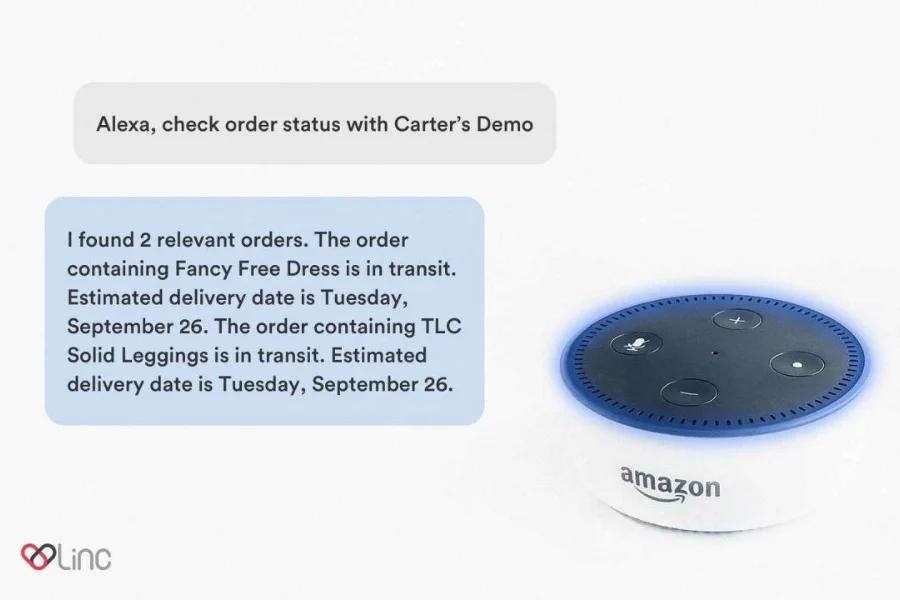
Conversational commerce through voice assistants can be a fun experience for the customers. All they need to do is use voice commands to look for the products or services they want to buy.
Conversational commerce examples and use case
Many businesses already leverage conversational commerce to create an omnichannel customer journey. By adopting it for your business, you, too, can achieve a competitive advantage in the market.
If you aren’t sure how to do that, here are a few examples to get inspired from.
1. prAna: Message apps
prAna is a well-known brand that sells sustainable clothing. It has been using Facebook Messenger to handle automated orders and inquiries.
The screenshot below shows how the Messenger bot works for the company.
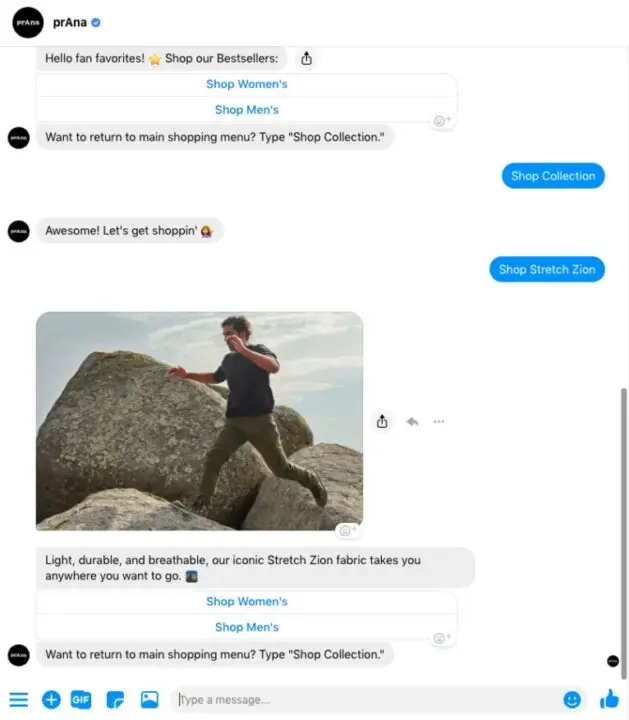
It gives the user the initial keywords until they mention specific products they are looking for. They also provide images of the product with an enticing description.
You, too, can use this strategy for your business to boost your sales and overall conversion goals.
2. 1-800-Flowers: Chatbots
1-800-Flowers is another brilliant example of conversational commerce use cases. It uses chatbots on its website to assist its online shoppers.
Using chatbots definitely takes a bit of implementation at the backend. But once it’s been tested and mastered, it can offer a seamless experience for your users.
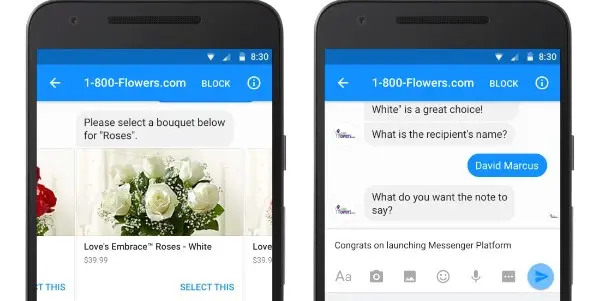
You, too, can use chatbots to offer an improved shopping experience to your users. Just think through the customer’s journey and their most common queries and work them into the bot.
3. eBay: Voice conversational commerce
eBay uses Google AssisteBay uses Google Assistant for its eBay Shopping Assistant program. By using this, users can talk to their devices and ask them to find their favorite eBay products.
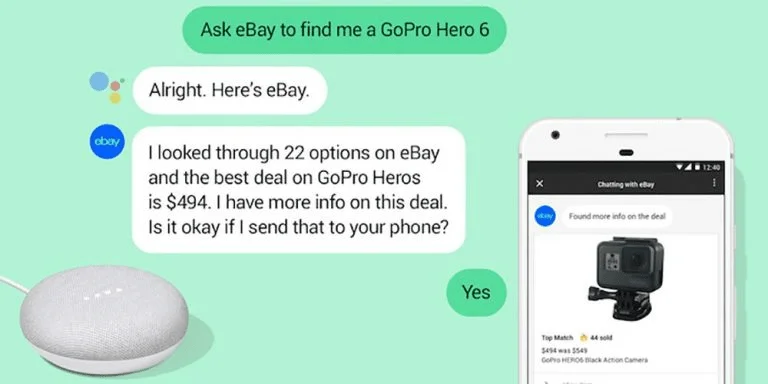
When the assistant finds something interesting for the customer, it sends the product info to the customer’s phone.
Voice conversational commerce is much easier and faster than typing. So it’s a good option for people with no concrete idea of what they want to buy.
Once they’re in the consideration stage, they’ll most likely want to see the products.
Voice conversational commerce is one of the more technologically-advanced conversational commerce examples. But voice chats will still fare best in combination with a live chat or chatbot feature.
4. Omnisend: Live chat
Omnisend uses the live chat feature, Omnibot, to manage customer inquiries effectively.
You’ll see this feature at work if you navigate to any page on the Omnisend website, especially the important pages like Pricing or Features.
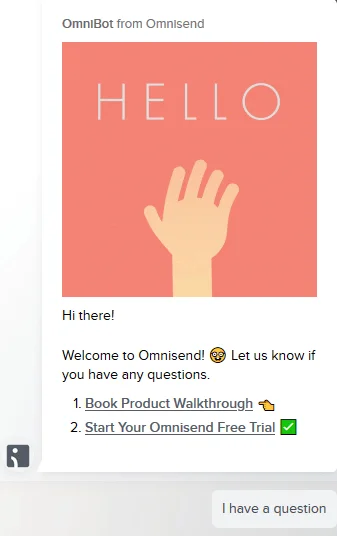
Here, users can start with two popular options. They can either have a demo with a product walkthrough or start for free to experience Omnisend firsthand.
There’s also an option for the visitor to enter their own question. Using this option, you can put them in contact with customer support.
When implementing your own live chat, think through your average customer’s journey and what the most probable questions or pain points might be.
Then, craft your strategy so that the customer has a great user experience throughout their journey.
Benefits of conversational commerce for your businesses
If you’re still wondering whether you should use conversational commerce for your business or not, here’s the thing.
If you want to have a competitive advantage in the market, now is the perfect time to optimize your business for it. Let me explain why.
In 2019, the conversational commerce market size was estimated at $5.94 billion, with an estimated compound annual growth rate (CAGR) of 26.3% from 2020 to 2027.
That would put the entire conversational commerce market size at $30.45 billion in 2027.
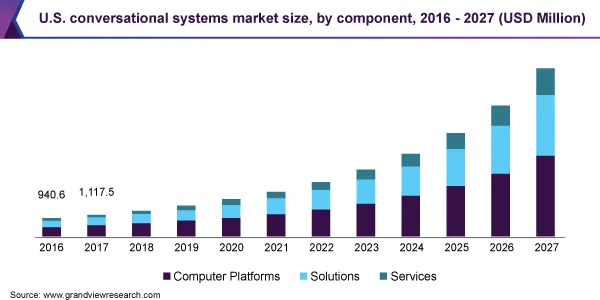
This is not just a positive sign for companies to start adopting conversational commerce but also a reflection of the growing demand for it.
Chris Messina popularized the term “conversational commerce” in a 2015 Medium post and described how it helped customers along their journey:
“Conversational commerce is about delivering convenience, personalization, and decision support while people are on the go, with only partial attention to spare.”
In many ways, conversational commerce can fit nicely into a business’s marketing strategy, helping it achieve its goals.
Let’s now look at a few benefits of conversational commerce that you can leverage for your business.
1. Improve customer experience through deeper personalization
With advancing technological development, consumer expectations are also evolving. Customers are demanding more personalized touches from ecommerce websites.
Customers are becoming accustomed to and are demanding more personalized touches from ecommerce websites.
Conversational commerce helps you meet those expectations and boost customer experience on your website.
By adopting it for your business, you can offer personalized recommendations and advice to your users.
An Epsilon study shows that 80% of consumers are more likely to buy from brands that offer a personalized experience.
You can also use it as a wonderful opportunity to upsell and cross-sell your products for more conversions.
2. Omnichannel integration
Conversational commerce works very well with a business’s critical omnichannel strategy.
There are roughly about 1.3 billion people using Facebook messenger and more than 2 billion people using Whatsapp worldwide.
Adopting conversational commerce allows brands to meet customers on platforms they are already actively using.
You can now reach out to customers across multiple channels. This makes things a lot easier for the customers. For businesses, too, the process becomes quick, easy, and a lot more efficient.
3. Better customer service
When you use conversational commerce for your business, you don’t send personalized messages manually on every channel. You automate your messages for your users.
This means you can now be available at your customer’s service 24/7. No more making customers wait for their pre or post-sales query answers.
4. Reduce cart abandonment rate and more conversions
Conversational commerce can also help you reduce cart abandonment rates and boost your conversions.
Every buying process starts with research. It’s normal for people to have doubts about a specific product in the pre-purchase phase.
This might affect their buying decision, and they might abandon their cart without completing the purchase.
Using conversational commerce can help you stop that. Instead of forgetting about these users, you can reach out to them and help them clarify their doubts.
This will help them make a better buying decision about your products. It’s a great way to reduce cart abandonment, boost conversions, and increase revenue.
INGLOT Canada boosted revenue by 4,798% by using various automation techniques:

Beyond the conversational commerce use cases depicted in the image above, there are several other techniques you can use to boost your conversions. These include:
- Instant messaging
- Conversational commerce bots
- Voice assistants
- Adding augmented reality into your conversations
How to optimize your business for conversational commerce
Any business can use conversational commerce. The platform on which the company website is published must be optimized.
This marketing strategy can be integrated into several conversational commerce platforms.
Omnisend, for example, is a great option for this. With it, you can integrate your business into conversational commerce apps and handle the entire customer’s journey. Moreover, you can offer your customers the right messages at the right time.
Register for free to see for yourself.
How to get started with conversational commerce
By now, you know how to optimize your business for conversational commerce, you might also want to know how to implement it in your marketing strategy.
So here are a few ways to get started.
1. Create your online store –
If you want to launch an ecommerce website, find a platform that works for you.
Many ecommerce businesses opt to go with Shopify. But there are several other alternatives, like WooCommerce or BigCommerce.
2. Choose your conversational commerce tool – Once your ecommerce website is ready, decide how you want to engage your customers. This can be through live chat, message apps, chatbots, voice chat, or any of its combinations.
Make sure you understand your customer’s journey well to communicate effectively with them.
3. Use an ecommerce marketing automation tool – It’s important for your conversational commerce tools to integrate well with your marketing automation.
Automation is crucial for the success of conversational commerce. It allows you to schedule timely, automated messages so you can focus on other parts of your business while knowing that your customers are well taken care of.
You can play around with the free version of tools like Omnisend and see how it can help your business.
4. Get viewers, subscribers, and buyers – Use other powerful marketing strategies like building an email list, creating relevant exit-intent pop-ups, and building a powerful social media strategy.
These strategies will help you attract more relevant leads to your online store. The more leads you have, the better it is for your ecommerce business.
5. Follow up with buyers – Do you want to convert your buyers into repeat customers? In that case, follow-ups are crucial.
The good thing is that you can use a strong automation marketing tool like Omnisend to make things smoother.
For example, with Omnisend, you can use segmentation (customer groupings) to find customers who completed a purchase within a specific time period.
They may be customers who need a refill or who never completed a purchase in the first place. So you can follow up with them to remind them to reorder their product, complete their purchase or even collect feedback.
6. Improve your business and scale – Once you’ve figured out what works for you, you are ready to scale your business. All you need to do now is to improve, rinse and repeat the process.
That being said, if you’re now ready to begin your ecommerce journey or improve it, you can start with Omnisend for free.
Wrap up
Conversational commerce is a new frontier in customer engagement and offers numerous benefits.
Businesses can provide personalized assistance, scale customer service efficiently, and leverage real-time interactions. Customers, in turn, enjoy convenience, instant support, and tailored recommendations.
However, conversational commerce also poses challenges. For instance, maintaining a balance between automation and the human touch is tricky.
But conversational commerce holds a lot of potential with the right strategies and tools. It can revolutionize the way consumers make purchases in the digital era.
Source from Omnisend
Disclaimer: The information set forth above is provided by Omnisend independently of Alibaba.com. Alibaba.com makes no representation and warranties as to the quality and reliability of the seller and products.








